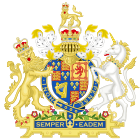
Back Acts of Union 1707 AF قانونا الاتحاد 1707 Arabic Zakon o ujedinjenju iz 1707. BS Acta d'Unió (1707) Catalan Униях акт (1707) CE Zákony o unii z roku 1707 Czech Deddfau Uno 1707 CY Acts of Union (1707) Danish Act of Union 1707 German Πράξεις της Ένωσης 1707 Greek
| Act of Parliament | |
 | |
| Long title | An Act for a Union of the Two Kingdoms of England and Scotland. |
|---|---|
| Citation | 6 Ann. c. 11 (Ruffhead: 5 Ann. c. 8) |
| Territorial extent | Kingdom of England |
| Dates | |
| Royal assent | 6 March 1707[b] |
| Commencement | 1 May 1707 |
| Other legislation | |
| Amended by | |
Status: Current legislation | |
| Text of the Union with Scotland Act 1706 as in force today (including any amendments) within the United Kingdom, from legislation.gov.uk. | |
| Act of Parliament | |
 | |
| Long title | Act Ratifying and Approving the Treaty of Union of the Two Kingdoms of Scotland and England. |
|---|---|
| Citation | 1707 c. 7 |
| Territorial extent | Kingdom of Scotland |
| Dates | |
| Royal assent | 16 January 1707 |
| Commencement | 1 May 1707 |
| Other legislation | |
| Amended by | |
Status: Current legislation | |
| Text of the Union with England Act 1707 as in force today (including any amendments) within the United Kingdom, from legislation.gov.uk. | |
The Acts of Union (Scottish Gaelic: Achd an Aonaidh) were two Acts of Parliament: the Union with Scotland Act 1706 passed by the Parliament of England, and the Union with England Act 1707 passed by the Parliament of Scotland. They put into effect the terms of the Treaty of Union that had been agreed on 22 July 1706, following negotiation between commissioners representing the parliaments of the two countries. By the two Acts, the Kingdom of England and the Kingdom of Scotland—which at the time were separate states in a personal union—were, in the words of the Treaty, "United into One Kingdom by the Name of Great Britain".[2]
The two countries had shared a monarch since the Union of the Crowns in 1603, when King James VI of Scotland inherited the English throne from his double first cousin twice removed, Queen Elizabeth I. Although described as a Union of Crowns, and in spite of James's acknowledgement of his accession to a single Crown,[3] England and Scotland were officially separate Kingdoms until 1707 (as opposed to the implied creation of a single unified Kingdom, exemplified by the later Kingdom of Great Britain). Prior to the Acts of Union, there had been three previous attempts (in 1606, 1667, and 1689) to unite the two countries by Acts of Parliament, but it was not until the early 18th century that both political establishments came to support the idea, albeit for different reasons.
The Acts took effect on 1 May 1707. On this date, the English Parliament and the Scottish Parliament united to form the Parliament of Great Britain, based in the Palace of Westminster in London, the previous home of the English Parliament.[4] This specific process is sometimes referred to as the "union of the Parliaments" in Scotland.[5]
Cite error: There are <ref group=lower-alpha> tags or {{efn}} templates on this page, but the references will not show without a {{reflist|group=lower-alpha}} template or {{notelist}} template (see the help page).
- ^ Pickering, Danby, ed. (1794). "CAP. XIII An act to prevent acts of parliament from taking effect from a time prior to the passing thereof". The Statutes at Large : Anno tricesimo tertio George III Regis. Vol. XXXIX. Cambridge. pp. 32, 33. Archived from the original on 20 March 2023. Retrieved 29 January 2021. (33 Geo. 3. c. 13: "Acts of Parliament (Commencement) Act 1793")
- ^ Article I of the Treaty of Union
- ^ "House of Commons Journal Volume 1: 31 March 1607". Archived from the original on 31 October 2020. Retrieved 27 October 2020.
- ^ Act of Union 1707, Article 3
- ^ "Glossary". archive2021.parliament.scot. 20 May 2010. Retrieved 14 January 2023.
